Enhancing Innovation: A Strategic Management Report for the WHO
VerifiedAdded on 2023/04/20
|11
|2759
|206
Report
AI Summary
This report delves into the critical aspects of innovation within the World Health Organization (WHO), examining its strengths and weaknesses in fostering creativity and innovation. It identifies key drivers such as the need for universally understandable innovative techniques, going beyond product development, and welcoming new ideas. The report highlights the environmental conditions impacting the WHO's operations and proposes an action plan focused on learning through collaboration, prioritizing innovation techniques, evaluating strengths and weaknesses, seeking feedback, and drawing inspiration from other organizations. It also addresses key implementation issues, including the integrative concepts of innovation and the lack of awareness, emphasizing the importance of a common understanding and comprehensive communication. The report concludes by outlining methods to evaluate the success of the proposed strategies, aiming to enhance the WHO's ability to meet its objectives and improve global health outcomes. Desklib provides access to this and other solved assignments to aid students in their studies.
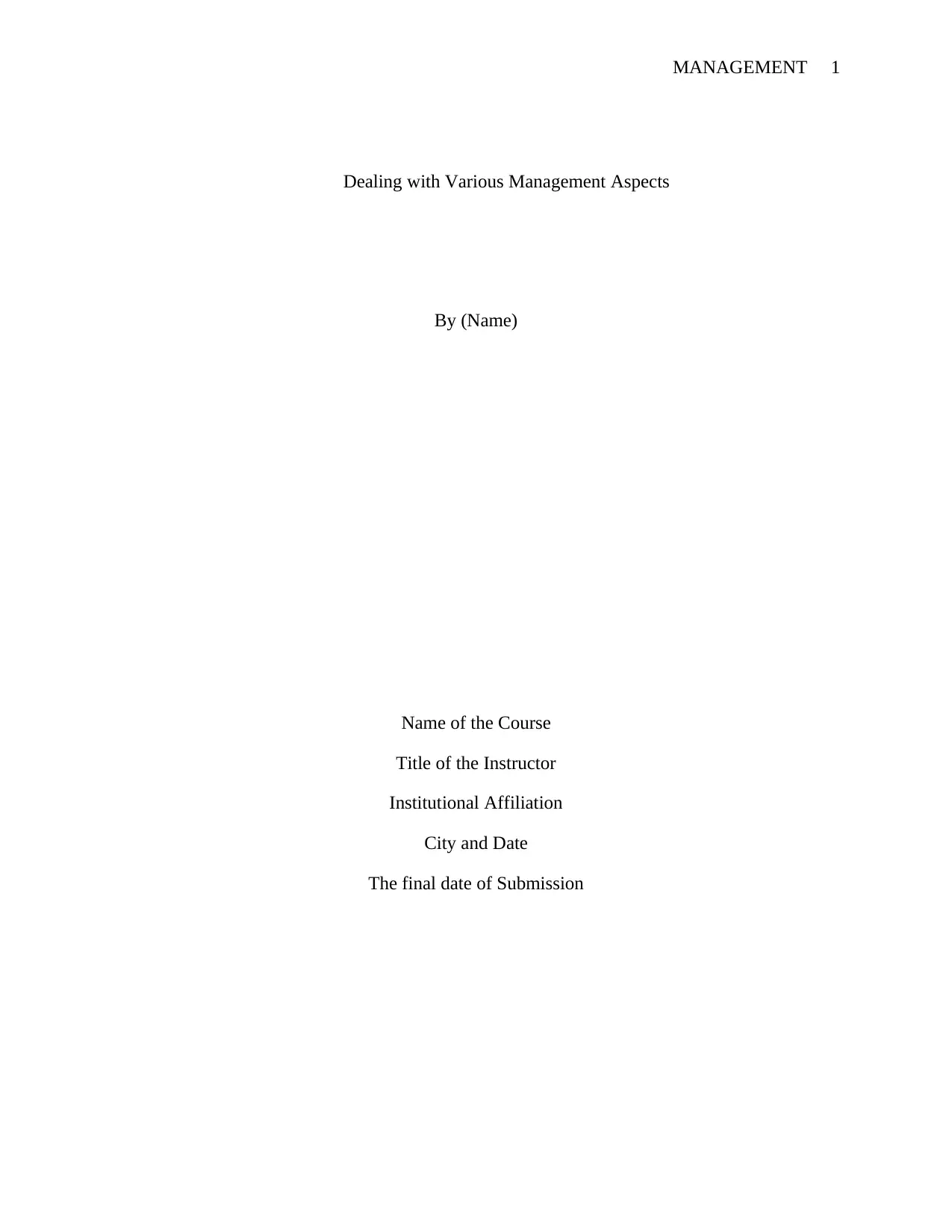
MANAGEMENT 1
Dealing with Various Management Aspects
By (Name)
Name of the Course
Title of the Instructor
Institutional Affiliation
City and Date
The final date of Submission
Dealing with Various Management Aspects
By (Name)
Name of the Course
Title of the Instructor
Institutional Affiliation
City and Date
The final date of Submission
Paraphrase This Document
Need a fresh take? Get an instant paraphrase of this document with our AI Paraphraser
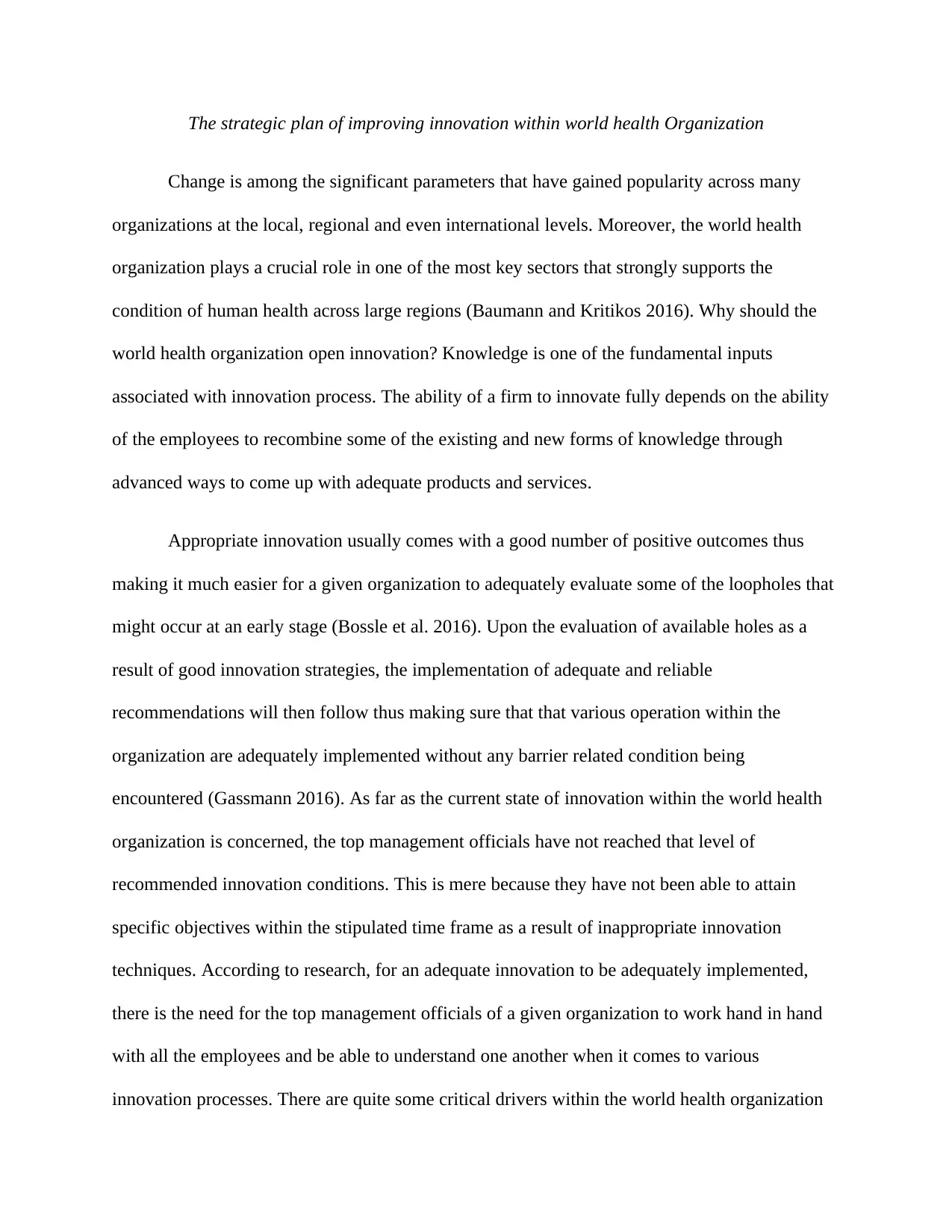
The strategic plan of improving innovation within world health Organization
Change is among the significant parameters that have gained popularity across many
organizations at the local, regional and even international levels. Moreover, the world health
organization plays a crucial role in one of the most key sectors that strongly supports the
condition of human health across large regions (Baumann and Kritikos 2016). Why should the
world health organization open innovation? Knowledge is one of the fundamental inputs
associated with innovation process. The ability of a firm to innovate fully depends on the ability
of the employees to recombine some of the existing and new forms of knowledge through
advanced ways to come up with adequate products and services.
Appropriate innovation usually comes with a good number of positive outcomes thus
making it much easier for a given organization to adequately evaluate some of the loopholes that
might occur at an early stage (Bossle et al. 2016). Upon the evaluation of available holes as a
result of good innovation strategies, the implementation of adequate and reliable
recommendations will then follow thus making sure that that various operation within the
organization are adequately implemented without any barrier related condition being
encountered (Gassmann 2016). As far as the current state of innovation within the world health
organization is concerned, the top management officials have not reached that level of
recommended innovation conditions. This is mere because they have not been able to attain
specific objectives within the stipulated time frame as a result of inappropriate innovation
techniques. According to research, for an adequate innovation to be adequately implemented,
there is the need for the top management officials of a given organization to work hand in hand
with all the employees and be able to understand one another when it comes to various
innovation processes. There are quite some critical drivers within the world health organization
Change is among the significant parameters that have gained popularity across many
organizations at the local, regional and even international levels. Moreover, the world health
organization plays a crucial role in one of the most key sectors that strongly supports the
condition of human health across large regions (Baumann and Kritikos 2016). Why should the
world health organization open innovation? Knowledge is one of the fundamental inputs
associated with innovation process. The ability of a firm to innovate fully depends on the ability
of the employees to recombine some of the existing and new forms of knowledge through
advanced ways to come up with adequate products and services.
Appropriate innovation usually comes with a good number of positive outcomes thus
making it much easier for a given organization to adequately evaluate some of the loopholes that
might occur at an early stage (Bossle et al. 2016). Upon the evaluation of available holes as a
result of good innovation strategies, the implementation of adequate and reliable
recommendations will then follow thus making sure that that various operation within the
organization are adequately implemented without any barrier related condition being
encountered (Gassmann 2016). As far as the current state of innovation within the world health
organization is concerned, the top management officials have not reached that level of
recommended innovation conditions. This is mere because they have not been able to attain
specific objectives within the stipulated time frame as a result of inappropriate innovation
techniques. According to research, for an adequate innovation to be adequately implemented,
there is the need for the top management officials of a given organization to work hand in hand
with all the employees and be able to understand one another when it comes to various
innovation processes. There are quite some critical drivers within the world health organization
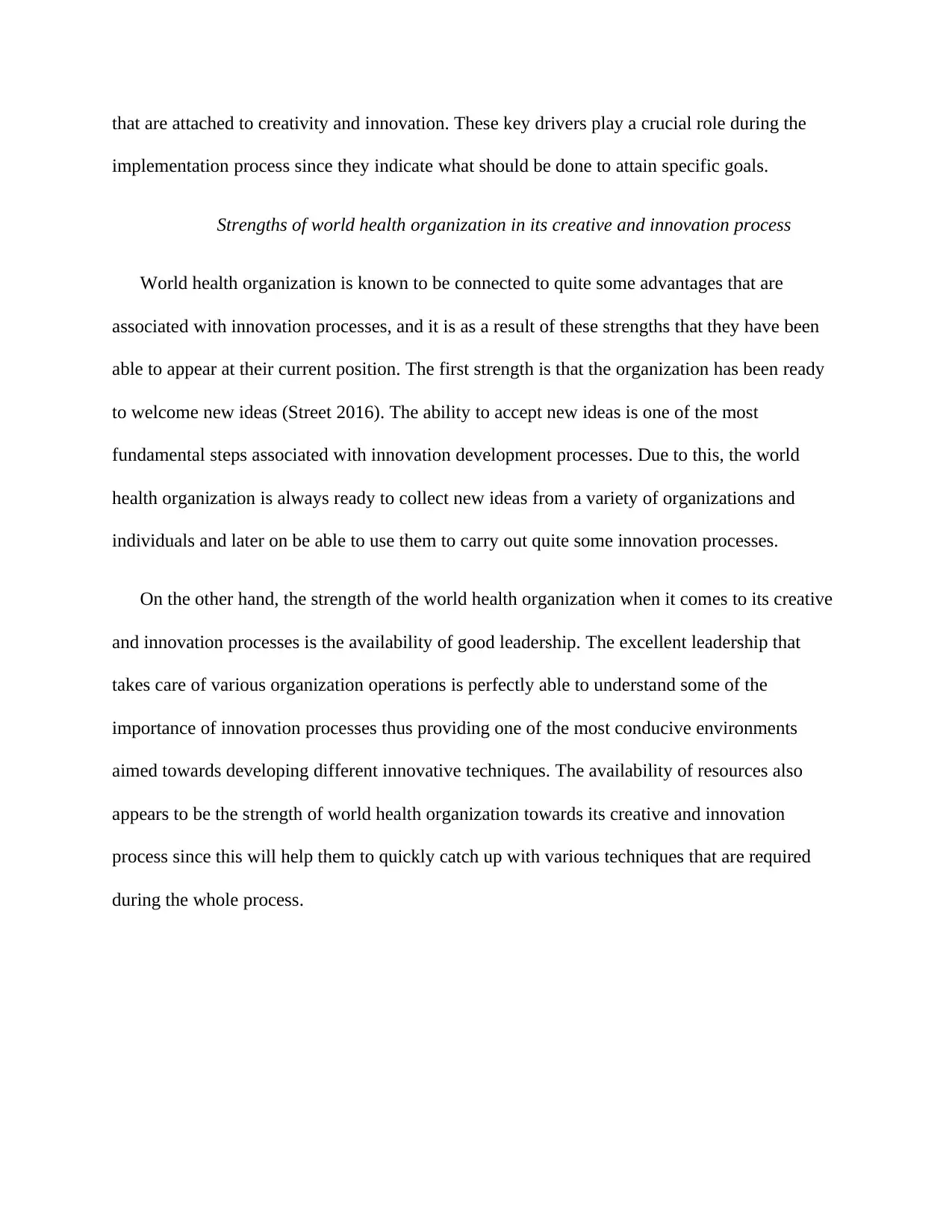
that are attached to creativity and innovation. These key drivers play a crucial role during the
implementation process since they indicate what should be done to attain specific goals.
Strengths of world health organization in its creative and innovation process
World health organization is known to be connected to quite some advantages that are
associated with innovation processes, and it is as a result of these strengths that they have been
able to appear at their current position. The first strength is that the organization has been ready
to welcome new ideas (Street 2016). The ability to accept new ideas is one of the most
fundamental steps associated with innovation development processes. Due to this, the world
health organization is always ready to collect new ideas from a variety of organizations and
individuals and later on be able to use them to carry out quite some innovation processes.
On the other hand, the strength of the world health organization when it comes to its creative
and innovation processes is the availability of good leadership. The excellent leadership that
takes care of various organization operations is perfectly able to understand some of the
importance of innovation processes thus providing one of the most conducive environments
aimed towards developing different innovative techniques. The availability of resources also
appears to be the strength of world health organization towards its creative and innovation
process since this will help them to quickly catch up with various techniques that are required
during the whole process.
implementation process since they indicate what should be done to attain specific goals.
Strengths of world health organization in its creative and innovation process
World health organization is known to be connected to quite some advantages that are
associated with innovation processes, and it is as a result of these strengths that they have been
able to appear at their current position. The first strength is that the organization has been ready
to welcome new ideas (Street 2016). The ability to accept new ideas is one of the most
fundamental steps associated with innovation development processes. Due to this, the world
health organization is always ready to collect new ideas from a variety of organizations and
individuals and later on be able to use them to carry out quite some innovation processes.
On the other hand, the strength of the world health organization when it comes to its creative
and innovation processes is the availability of good leadership. The excellent leadership that
takes care of various organization operations is perfectly able to understand some of the
importance of innovation processes thus providing one of the most conducive environments
aimed towards developing different innovative techniques. The availability of resources also
appears to be the strength of world health organization towards its creative and innovation
process since this will help them to quickly catch up with various techniques that are required
during the whole process.
⊘ This is a preview!⊘
Do you want full access?
Subscribe today to unlock all pages.

Trusted by 1+ million students worldwide
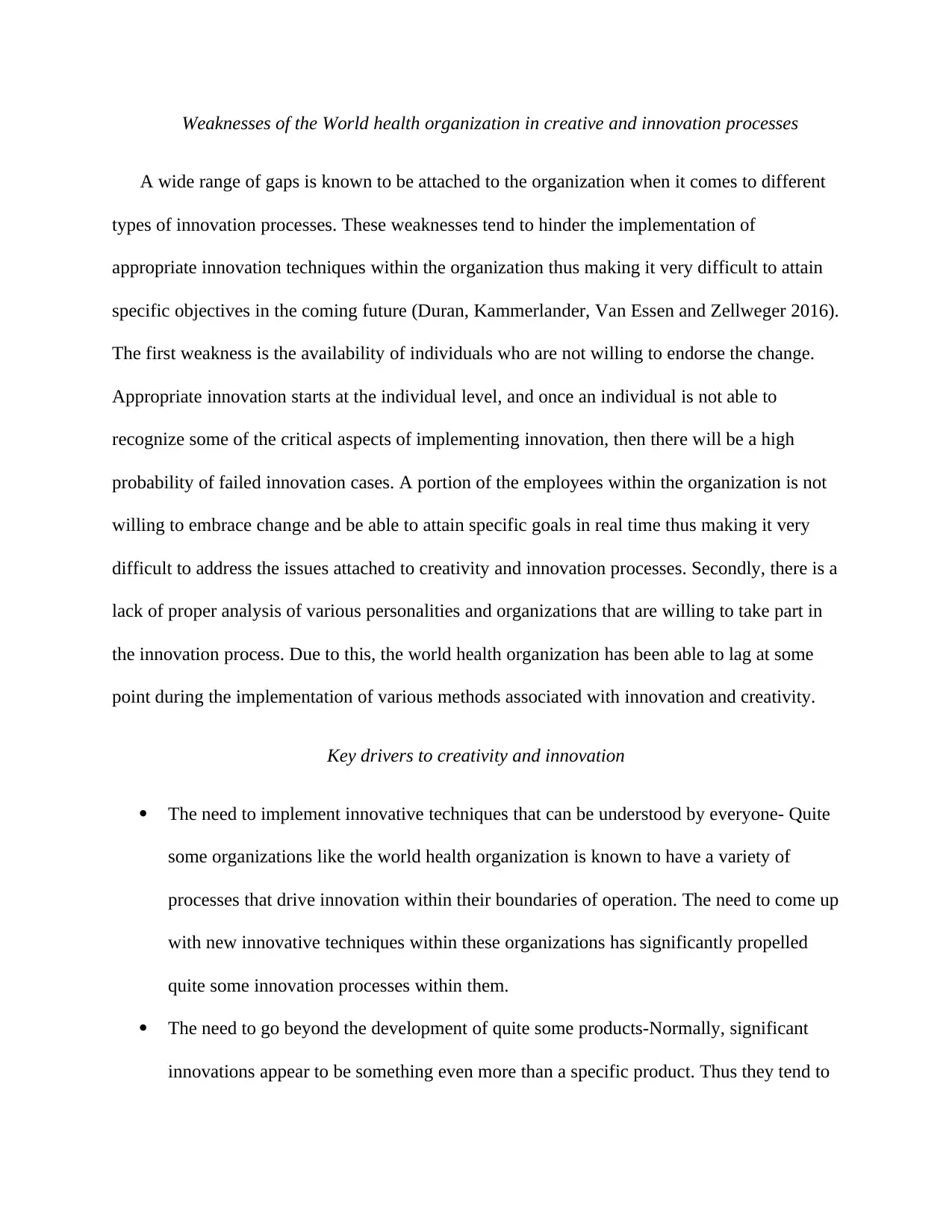
Weaknesses of the World health organization in creative and innovation processes
A wide range of gaps is known to be attached to the organization when it comes to different
types of innovation processes. These weaknesses tend to hinder the implementation of
appropriate innovation techniques within the organization thus making it very difficult to attain
specific objectives in the coming future (Duran, Kammerlander, Van Essen and Zellweger 2016).
The first weakness is the availability of individuals who are not willing to endorse the change.
Appropriate innovation starts at the individual level, and once an individual is not able to
recognize some of the critical aspects of implementing innovation, then there will be a high
probability of failed innovation cases. A portion of the employees within the organization is not
willing to embrace change and be able to attain specific goals in real time thus making it very
difficult to address the issues attached to creativity and innovation processes. Secondly, there is a
lack of proper analysis of various personalities and organizations that are willing to take part in
the innovation process. Due to this, the world health organization has been able to lag at some
point during the implementation of various methods associated with innovation and creativity.
Key drivers to creativity and innovation
The need to implement innovative techniques that can be understood by everyone- Quite
some organizations like the world health organization is known to have a variety of
processes that drive innovation within their boundaries of operation. The need to come up
with new innovative techniques within these organizations has significantly propelled
quite some innovation processes within them.
The need to go beyond the development of quite some products-Normally, significant
innovations appear to be something even more than a specific product. Thus they tend to
A wide range of gaps is known to be attached to the organization when it comes to different
types of innovation processes. These weaknesses tend to hinder the implementation of
appropriate innovation techniques within the organization thus making it very difficult to attain
specific objectives in the coming future (Duran, Kammerlander, Van Essen and Zellweger 2016).
The first weakness is the availability of individuals who are not willing to endorse the change.
Appropriate innovation starts at the individual level, and once an individual is not able to
recognize some of the critical aspects of implementing innovation, then there will be a high
probability of failed innovation cases. A portion of the employees within the organization is not
willing to embrace change and be able to attain specific goals in real time thus making it very
difficult to address the issues attached to creativity and innovation processes. Secondly, there is a
lack of proper analysis of various personalities and organizations that are willing to take part in
the innovation process. Due to this, the world health organization has been able to lag at some
point during the implementation of various methods associated with innovation and creativity.
Key drivers to creativity and innovation
The need to implement innovative techniques that can be understood by everyone- Quite
some organizations like the world health organization is known to have a variety of
processes that drive innovation within their boundaries of operation. The need to come up
with new innovative techniques within these organizations has significantly propelled
quite some innovation processes within them.
The need to go beyond the development of quite some products-Normally, significant
innovations appear to be something even more than a specific product. Thus they tend to
Paraphrase This Document
Need a fresh take? Get an instant paraphrase of this document with our AI Paraphraser
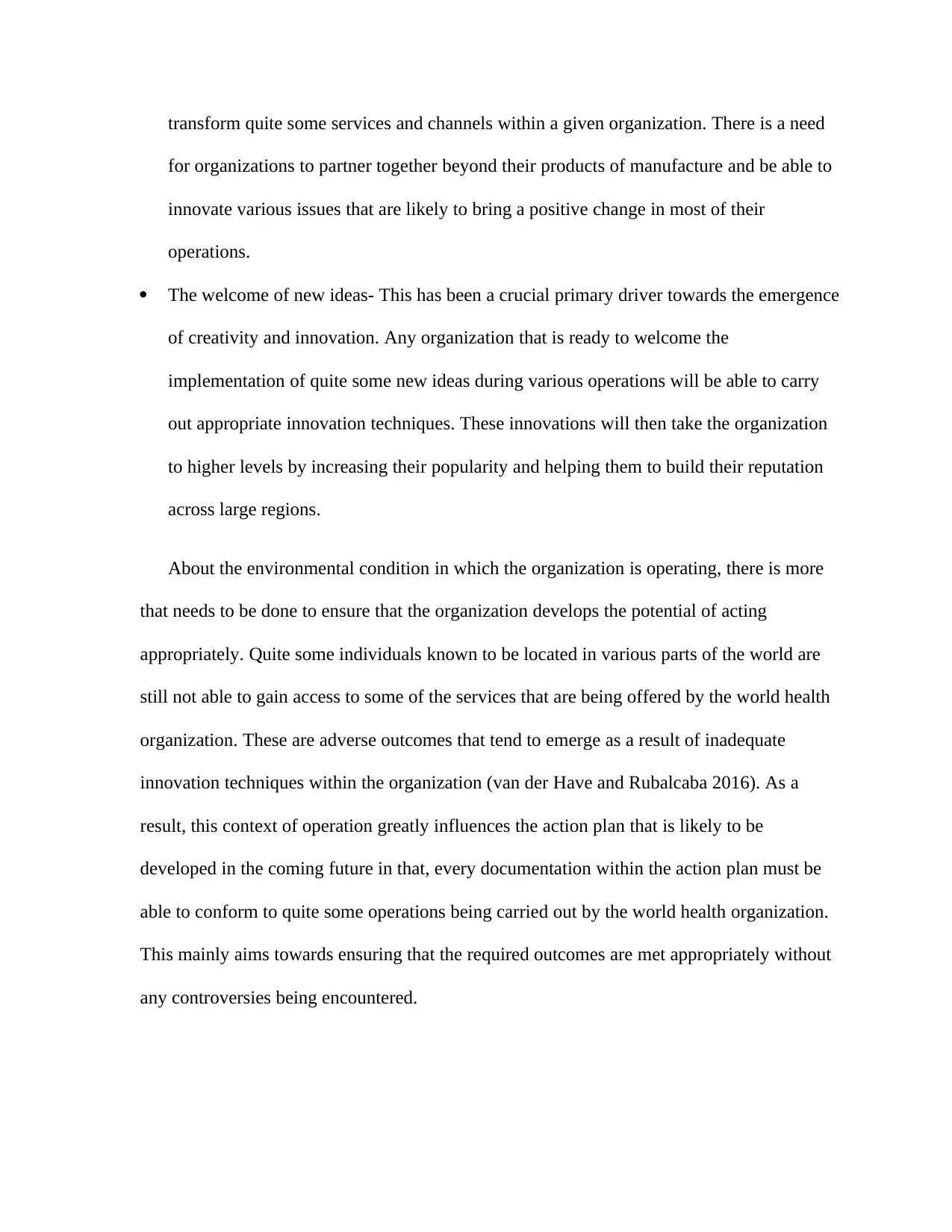
transform quite some services and channels within a given organization. There is a need
for organizations to partner together beyond their products of manufacture and be able to
innovate various issues that are likely to bring a positive change in most of their
operations.
The welcome of new ideas- This has been a crucial primary driver towards the emergence
of creativity and innovation. Any organization that is ready to welcome the
implementation of quite some new ideas during various operations will be able to carry
out appropriate innovation techniques. These innovations will then take the organization
to higher levels by increasing their popularity and helping them to build their reputation
across large regions.
About the environmental condition in which the organization is operating, there is more
that needs to be done to ensure that the organization develops the potential of acting
appropriately. Quite some individuals known to be located in various parts of the world are
still not able to gain access to some of the services that are being offered by the world health
organization. These are adverse outcomes that tend to emerge as a result of inadequate
innovation techniques within the organization (van der Have and Rubalcaba 2016). As a
result, this context of operation greatly influences the action plan that is likely to be
developed in the coming future in that, every documentation within the action plan must be
able to conform to quite some operations being carried out by the world health organization.
This mainly aims towards ensuring that the required outcomes are met appropriately without
any controversies being encountered.
for organizations to partner together beyond their products of manufacture and be able to
innovate various issues that are likely to bring a positive change in most of their
operations.
The welcome of new ideas- This has been a crucial primary driver towards the emergence
of creativity and innovation. Any organization that is ready to welcome the
implementation of quite some new ideas during various operations will be able to carry
out appropriate innovation techniques. These innovations will then take the organization
to higher levels by increasing their popularity and helping them to build their reputation
across large regions.
About the environmental condition in which the organization is operating, there is more
that needs to be done to ensure that the organization develops the potential of acting
appropriately. Quite some individuals known to be located in various parts of the world are
still not able to gain access to some of the services that are being offered by the world health
organization. These are adverse outcomes that tend to emerge as a result of inadequate
innovation techniques within the organization (van der Have and Rubalcaba 2016). As a
result, this context of operation greatly influences the action plan that is likely to be
developed in the coming future in that, every documentation within the action plan must be
able to conform to quite some operations being carried out by the world health organization.
This mainly aims towards ensuring that the required outcomes are met appropriately without
any controversies being encountered.
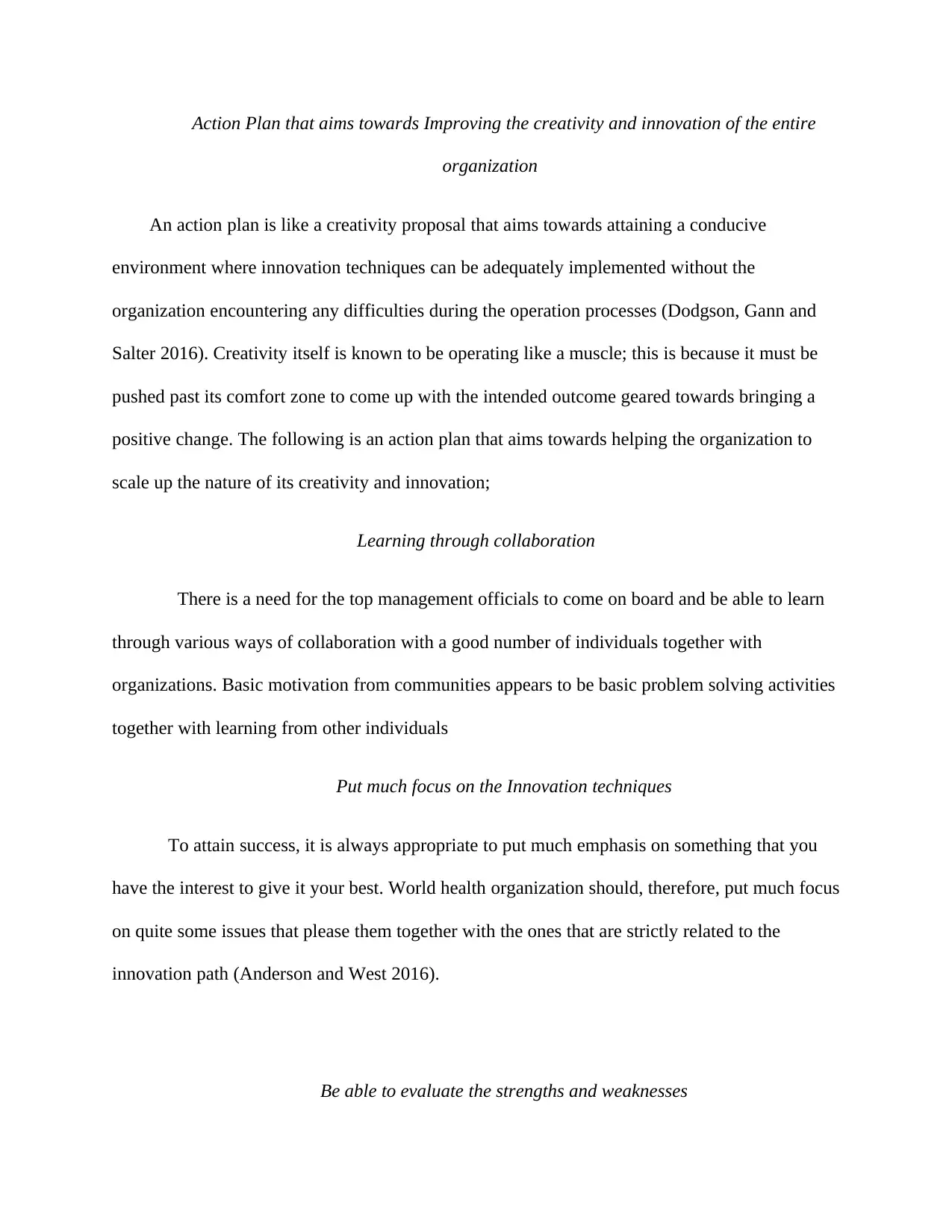
Action Plan that aims towards Improving the creativity and innovation of the entire
organization
An action plan is like a creativity proposal that aims towards attaining a conducive
environment where innovation techniques can be adequately implemented without the
organization encountering any difficulties during the operation processes (Dodgson, Gann and
Salter 2016). Creativity itself is known to be operating like a muscle; this is because it must be
pushed past its comfort zone to come up with the intended outcome geared towards bringing a
positive change. The following is an action plan that aims towards helping the organization to
scale up the nature of its creativity and innovation;
Learning through collaboration
There is a need for the top management officials to come on board and be able to learn
through various ways of collaboration with a good number of individuals together with
organizations. Basic motivation from communities appears to be basic problem solving activities
together with learning from other individuals
Put much focus on the Innovation techniques
To attain success, it is always appropriate to put much emphasis on something that you
have the interest to give it your best. World health organization should, therefore, put much focus
on quite some issues that please them together with the ones that are strictly related to the
innovation path (Anderson and West 2016).
Be able to evaluate the strengths and weaknesses
organization
An action plan is like a creativity proposal that aims towards attaining a conducive
environment where innovation techniques can be adequately implemented without the
organization encountering any difficulties during the operation processes (Dodgson, Gann and
Salter 2016). Creativity itself is known to be operating like a muscle; this is because it must be
pushed past its comfort zone to come up with the intended outcome geared towards bringing a
positive change. The following is an action plan that aims towards helping the organization to
scale up the nature of its creativity and innovation;
Learning through collaboration
There is a need for the top management officials to come on board and be able to learn
through various ways of collaboration with a good number of individuals together with
organizations. Basic motivation from communities appears to be basic problem solving activities
together with learning from other individuals
Put much focus on the Innovation techniques
To attain success, it is always appropriate to put much emphasis on something that you
have the interest to give it your best. World health organization should, therefore, put much focus
on quite some issues that please them together with the ones that are strictly related to the
innovation path (Anderson and West 2016).
Be able to evaluate the strengths and weaknesses
⊘ This is a preview!⊘
Do you want full access?
Subscribe today to unlock all pages.

Trusted by 1+ million students worldwide
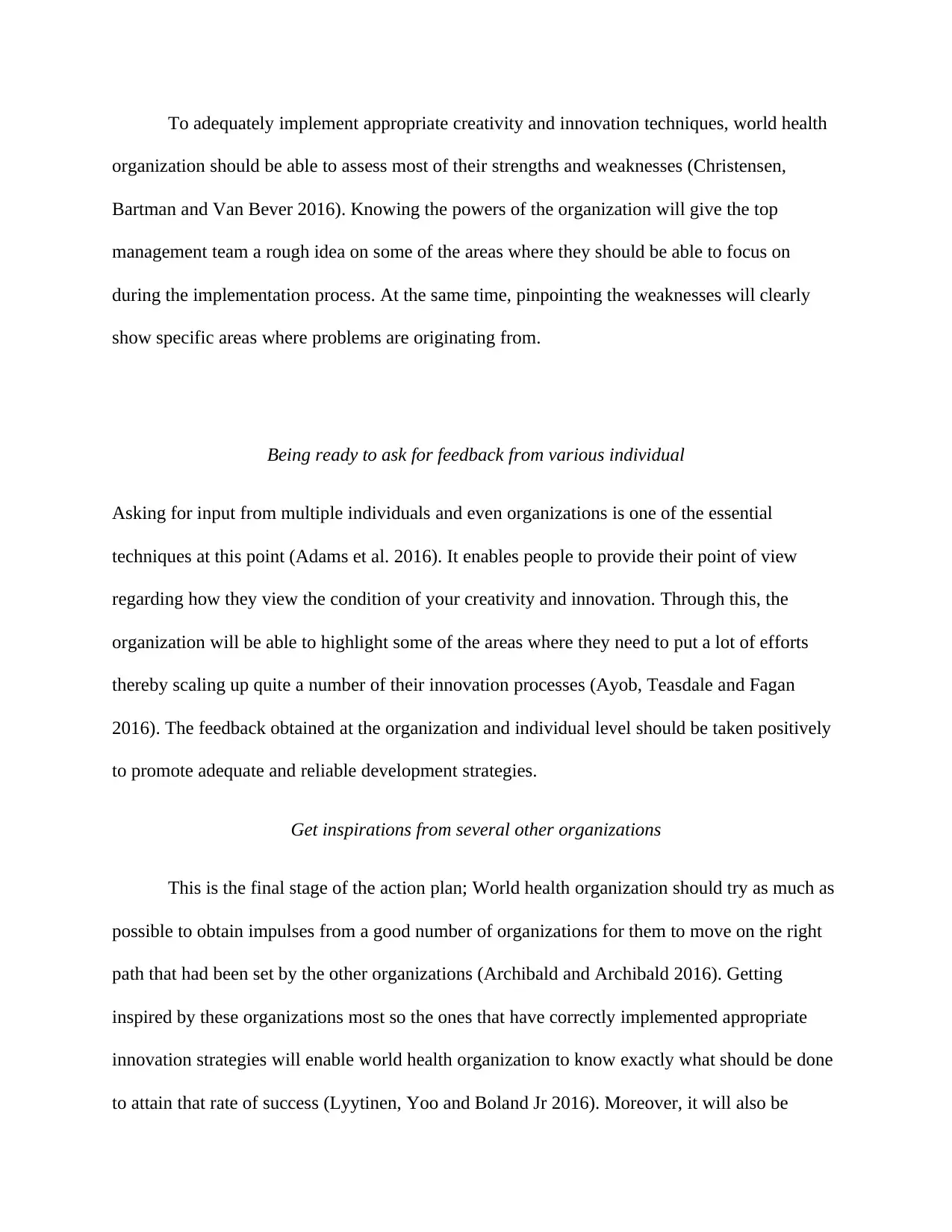
To adequately implement appropriate creativity and innovation techniques, world health
organization should be able to assess most of their strengths and weaknesses (Christensen,
Bartman and Van Bever 2016). Knowing the powers of the organization will give the top
management team a rough idea on some of the areas where they should be able to focus on
during the implementation process. At the same time, pinpointing the weaknesses will clearly
show specific areas where problems are originating from.
Being ready to ask for feedback from various individual
Asking for input from multiple individuals and even organizations is one of the essential
techniques at this point (Adams et al. 2016). It enables people to provide their point of view
regarding how they view the condition of your creativity and innovation. Through this, the
organization will be able to highlight some of the areas where they need to put a lot of efforts
thereby scaling up quite a number of their innovation processes (Ayob, Teasdale and Fagan
2016). The feedback obtained at the organization and individual level should be taken positively
to promote adequate and reliable development strategies.
Get inspirations from several other organizations
This is the final stage of the action plan; World health organization should try as much as
possible to obtain impulses from a good number of organizations for them to move on the right
path that had been set by the other organizations (Archibald and Archibald 2016). Getting
inspired by these organizations most so the ones that have correctly implemented appropriate
innovation strategies will enable world health organization to know exactly what should be done
to attain that rate of success (Lyytinen, Yoo and Boland Jr 2016). Moreover, it will also be
organization should be able to assess most of their strengths and weaknesses (Christensen,
Bartman and Van Bever 2016). Knowing the powers of the organization will give the top
management team a rough idea on some of the areas where they should be able to focus on
during the implementation process. At the same time, pinpointing the weaknesses will clearly
show specific areas where problems are originating from.
Being ready to ask for feedback from various individual
Asking for input from multiple individuals and even organizations is one of the essential
techniques at this point (Adams et al. 2016). It enables people to provide their point of view
regarding how they view the condition of your creativity and innovation. Through this, the
organization will be able to highlight some of the areas where they need to put a lot of efforts
thereby scaling up quite a number of their innovation processes (Ayob, Teasdale and Fagan
2016). The feedback obtained at the organization and individual level should be taken positively
to promote adequate and reliable development strategies.
Get inspirations from several other organizations
This is the final stage of the action plan; World health organization should try as much as
possible to obtain impulses from a good number of organizations for them to move on the right
path that had been set by the other organizations (Archibald and Archibald 2016). Getting
inspired by these organizations most so the ones that have correctly implemented appropriate
innovation strategies will enable world health organization to know exactly what should be done
to attain that rate of success (Lyytinen, Yoo and Boland Jr 2016). Moreover, it will also be
Paraphrase This Document
Need a fresh take? Get an instant paraphrase of this document with our AI Paraphraser
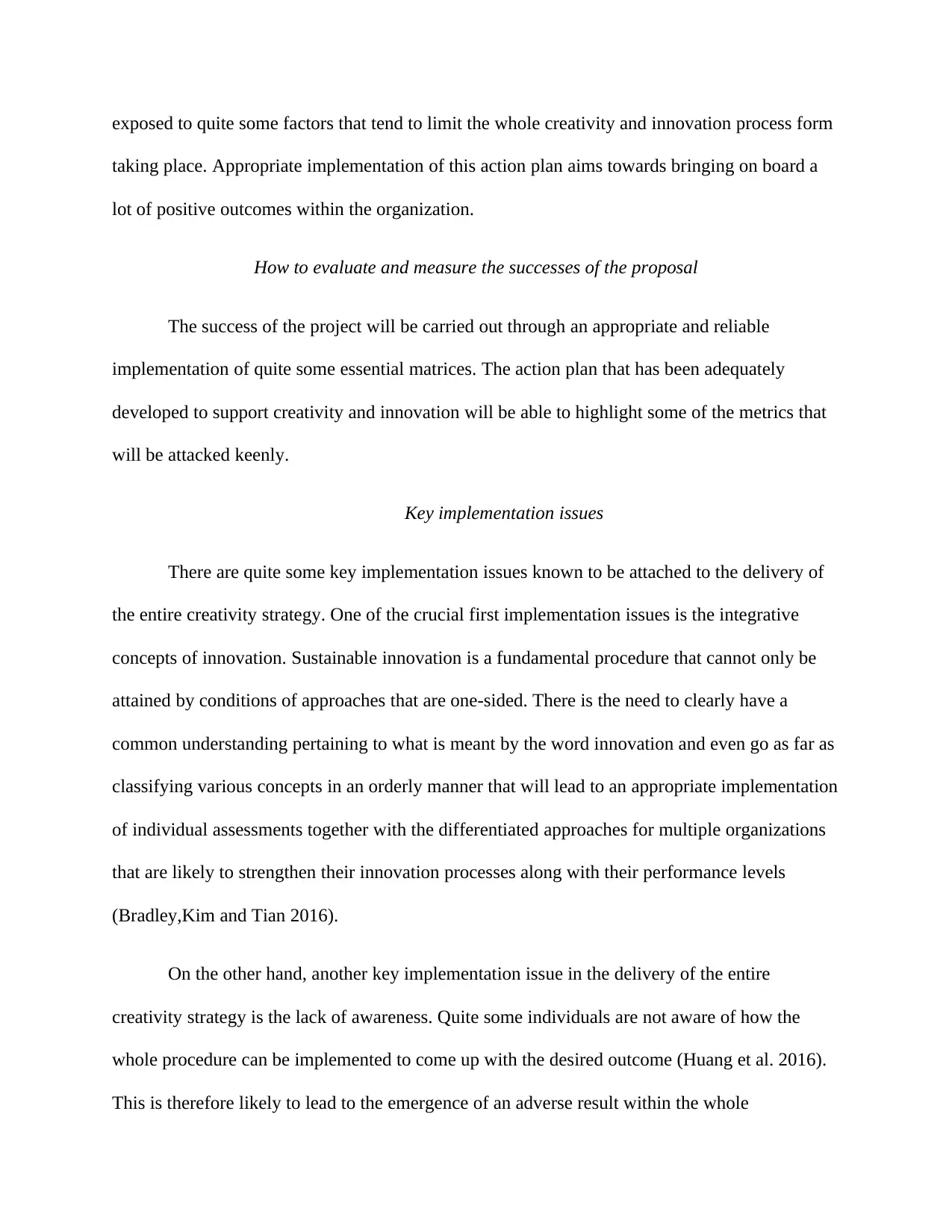
exposed to quite some factors that tend to limit the whole creativity and innovation process form
taking place. Appropriate implementation of this action plan aims towards bringing on board a
lot of positive outcomes within the organization.
How to evaluate and measure the successes of the proposal
The success of the project will be carried out through an appropriate and reliable
implementation of quite some essential matrices. The action plan that has been adequately
developed to support creativity and innovation will be able to highlight some of the metrics that
will be attacked keenly.
Key implementation issues
There are quite some key implementation issues known to be attached to the delivery of
the entire creativity strategy. One of the crucial first implementation issues is the integrative
concepts of innovation. Sustainable innovation is a fundamental procedure that cannot only be
attained by conditions of approaches that are one-sided. There is the need to clearly have a
common understanding pertaining to what is meant by the word innovation and even go as far as
classifying various concepts in an orderly manner that will lead to an appropriate implementation
of individual assessments together with the differentiated approaches for multiple organizations
that are likely to strengthen their innovation processes along with their performance levels
(Bradley,Kim and Tian 2016).
On the other hand, another key implementation issue in the delivery of the entire
creativity strategy is the lack of awareness. Quite some individuals are not aware of how the
whole procedure can be implemented to come up with the desired outcome (Huang et al. 2016).
This is therefore likely to lead to the emergence of an adverse result within the whole
taking place. Appropriate implementation of this action plan aims towards bringing on board a
lot of positive outcomes within the organization.
How to evaluate and measure the successes of the proposal
The success of the project will be carried out through an appropriate and reliable
implementation of quite some essential matrices. The action plan that has been adequately
developed to support creativity and innovation will be able to highlight some of the metrics that
will be attacked keenly.
Key implementation issues
There are quite some key implementation issues known to be attached to the delivery of
the entire creativity strategy. One of the crucial first implementation issues is the integrative
concepts of innovation. Sustainable innovation is a fundamental procedure that cannot only be
attained by conditions of approaches that are one-sided. There is the need to clearly have a
common understanding pertaining to what is meant by the word innovation and even go as far as
classifying various concepts in an orderly manner that will lead to an appropriate implementation
of individual assessments together with the differentiated approaches for multiple organizations
that are likely to strengthen their innovation processes along with their performance levels
(Bradley,Kim and Tian 2016).
On the other hand, another key implementation issue in the delivery of the entire
creativity strategy is the lack of awareness. Quite some individuals are not aware of how the
whole procedure can be implemented to come up with the desired outcome (Huang et al. 2016).
This is therefore likely to lead to the emergence of an adverse result within the whole
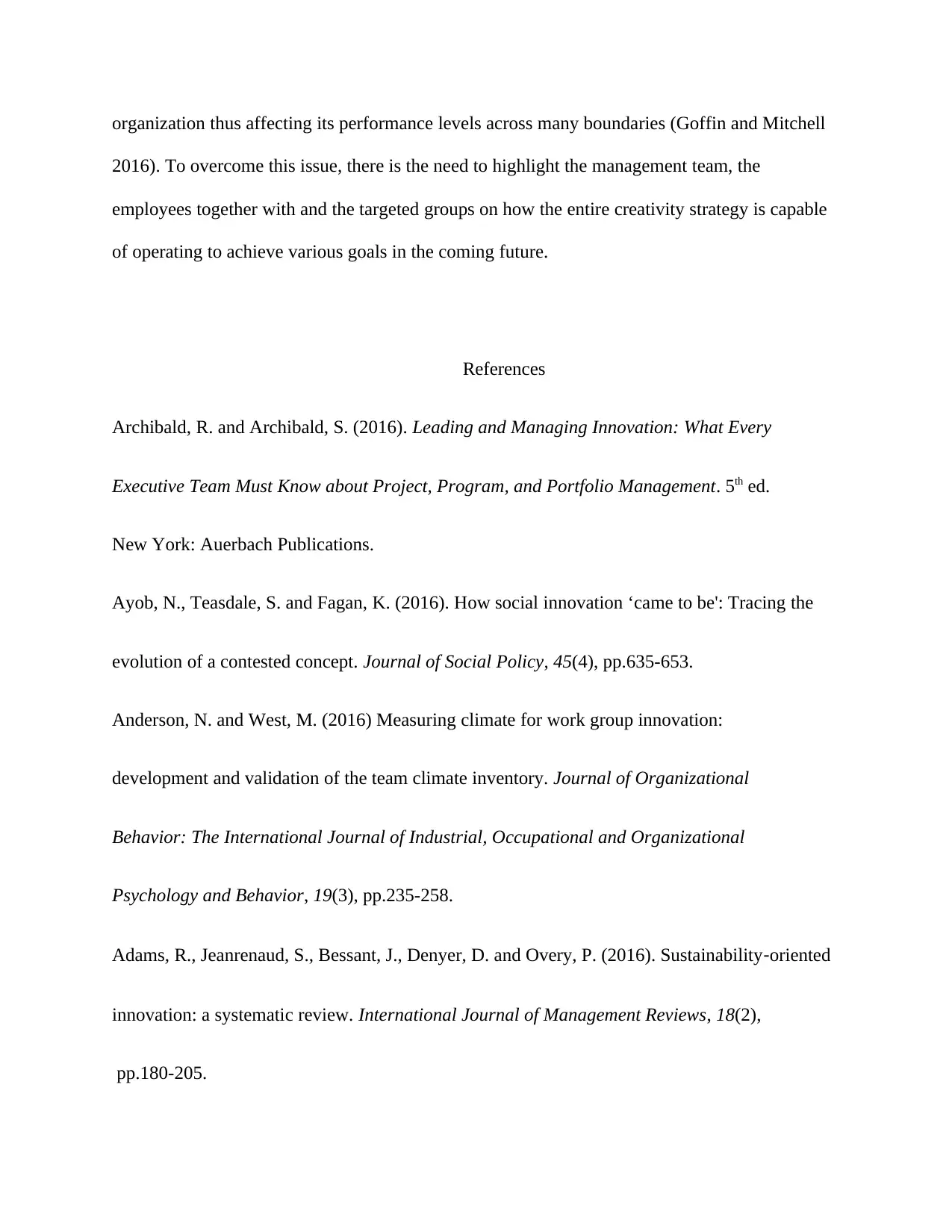
organization thus affecting its performance levels across many boundaries (Goffin and Mitchell
2016). To overcome this issue, there is the need to highlight the management team, the
employees together with and the targeted groups on how the entire creativity strategy is capable
of operating to achieve various goals in the coming future.
References
Archibald, R. and Archibald, S. (2016). Leading and Managing Innovation: What Every
Executive Team Must Know about Project, Program, and Portfolio Management. 5th ed.
New York: Auerbach Publications.
Ayob, N., Teasdale, S. and Fagan, K. (2016). How social innovation ‘came to be': Tracing the
evolution of a contested concept. Journal of Social Policy, 45(4), pp.635-653.
Anderson, N. and West, M. (2016) Measuring climate for work group innovation:
development and validation of the team climate inventory. Journal of Organizational
Behavior: The International Journal of Industrial, Occupational and Organizational
Psychology and Behavior, 19(3), pp.235-258.
Adams, R., Jeanrenaud, S., Bessant, J., Denyer, D. and Overy, P. (2016). Sustainability‐oriented
innovation: a systematic review. International Journal of Management Reviews, 18(2),
pp.180-205.
2016). To overcome this issue, there is the need to highlight the management team, the
employees together with and the targeted groups on how the entire creativity strategy is capable
of operating to achieve various goals in the coming future.
References
Archibald, R. and Archibald, S. (2016). Leading and Managing Innovation: What Every
Executive Team Must Know about Project, Program, and Portfolio Management. 5th ed.
New York: Auerbach Publications.
Ayob, N., Teasdale, S. and Fagan, K. (2016). How social innovation ‘came to be': Tracing the
evolution of a contested concept. Journal of Social Policy, 45(4), pp.635-653.
Anderson, N. and West, M. (2016) Measuring climate for work group innovation:
development and validation of the team climate inventory. Journal of Organizational
Behavior: The International Journal of Industrial, Occupational and Organizational
Psychology and Behavior, 19(3), pp.235-258.
Adams, R., Jeanrenaud, S., Bessant, J., Denyer, D. and Overy, P. (2016). Sustainability‐oriented
innovation: a systematic review. International Journal of Management Reviews, 18(2),
pp.180-205.
⊘ This is a preview!⊘
Do you want full access?
Subscribe today to unlock all pages.

Trusted by 1+ million students worldwide
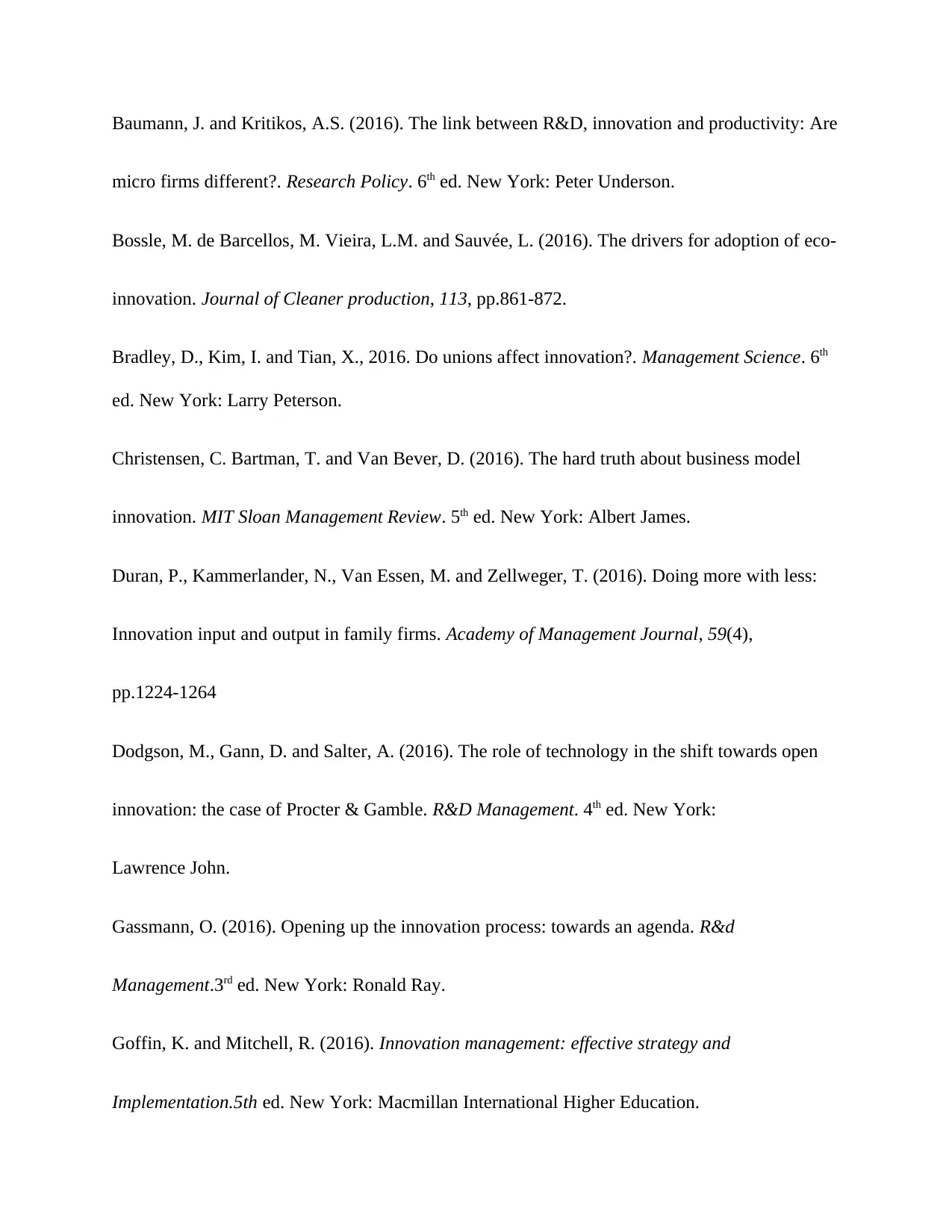
Baumann, J. and Kritikos, A.S. (2016). The link between R&D, innovation and productivity: Are
micro firms different?. Research Policy. 6th ed. New York: Peter Underson.
Bossle, M. de Barcellos, M. Vieira, L.M. and Sauvée, L. (2016). The drivers for adoption of eco-
innovation. Journal of Cleaner production, 113, pp.861-872.
Bradley, D., Kim, I. and Tian, X., 2016. Do unions affect innovation?. Management Science. 6th
ed. New York: Larry Peterson.
Christensen, C. Bartman, T. and Van Bever, D. (2016). The hard truth about business model
innovation. MIT Sloan Management Review. 5th ed. New York: Albert James.
Duran, P., Kammerlander, N., Van Essen, M. and Zellweger, T. (2016). Doing more with less:
Innovation input and output in family firms. Academy of Management Journal, 59(4),
pp.1224-1264
Dodgson, M., Gann, D. and Salter, A. (2016). The role of technology in the shift towards open
innovation: the case of Procter & Gamble. R&D Management. 4th ed. New York:
Lawrence John.
Gassmann, O. (2016). Opening up the innovation process: towards an agenda. R&d
Management.3rd ed. New York: Ronald Ray.
Goffin, K. and Mitchell, R. (2016). Innovation management: effective strategy and
Implementation.5th ed. New York: Macmillan International Higher Education.
micro firms different?. Research Policy. 6th ed. New York: Peter Underson.
Bossle, M. de Barcellos, M. Vieira, L.M. and Sauvée, L. (2016). The drivers for adoption of eco-
innovation. Journal of Cleaner production, 113, pp.861-872.
Bradley, D., Kim, I. and Tian, X., 2016. Do unions affect innovation?. Management Science. 6th
ed. New York: Larry Peterson.
Christensen, C. Bartman, T. and Van Bever, D. (2016). The hard truth about business model
innovation. MIT Sloan Management Review. 5th ed. New York: Albert James.
Duran, P., Kammerlander, N., Van Essen, M. and Zellweger, T. (2016). Doing more with less:
Innovation input and output in family firms. Academy of Management Journal, 59(4),
pp.1224-1264
Dodgson, M., Gann, D. and Salter, A. (2016). The role of technology in the shift towards open
innovation: the case of Procter & Gamble. R&D Management. 4th ed. New York:
Lawrence John.
Gassmann, O. (2016). Opening up the innovation process: towards an agenda. R&d
Management.3rd ed. New York: Ronald Ray.
Goffin, K. and Mitchell, R. (2016). Innovation management: effective strategy and
Implementation.5th ed. New York: Macmillan International Higher Education.
Paraphrase This Document
Need a fresh take? Get an instant paraphrase of this document with our AI Paraphraser
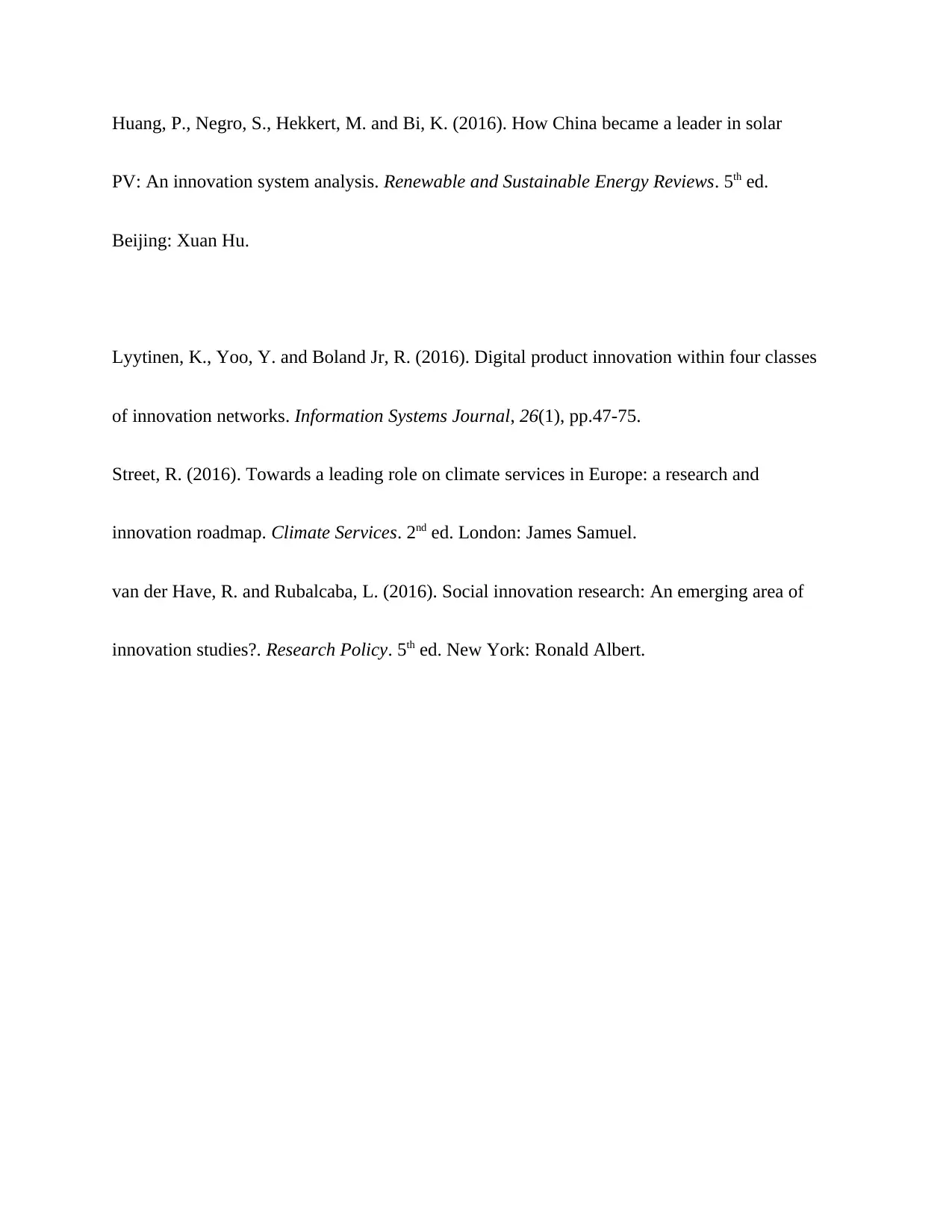
Huang, P., Negro, S., Hekkert, M. and Bi, K. (2016). How China became a leader in solar
PV: An innovation system analysis. Renewable and Sustainable Energy Reviews. 5th ed.
Beijing: Xuan Hu.
Lyytinen, K., Yoo, Y. and Boland Jr, R. (2016). Digital product innovation within four classes
of innovation networks. Information Systems Journal, 26(1), pp.47-75.
Street, R. (2016). Towards a leading role on climate services in Europe: a research and
innovation roadmap. Climate Services. 2nd ed. London: James Samuel.
van der Have, R. and Rubalcaba, L. (2016). Social innovation research: An emerging area of
innovation studies?. Research Policy. 5th ed. New York: Ronald Albert.
PV: An innovation system analysis. Renewable and Sustainable Energy Reviews. 5th ed.
Beijing: Xuan Hu.
Lyytinen, K., Yoo, Y. and Boland Jr, R. (2016). Digital product innovation within four classes
of innovation networks. Information Systems Journal, 26(1), pp.47-75.
Street, R. (2016). Towards a leading role on climate services in Europe: a research and
innovation roadmap. Climate Services. 2nd ed. London: James Samuel.
van der Have, R. and Rubalcaba, L. (2016). Social innovation research: An emerging area of
innovation studies?. Research Policy. 5th ed. New York: Ronald Albert.
1 out of 11
Related Documents
Your All-in-One AI-Powered Toolkit for Academic Success.
+13062052269
info@desklib.com
Available 24*7 on WhatsApp / Email
![[object Object]](/_next/static/media/star-bottom.7253800d.svg)
Unlock your academic potential
Copyright © 2020–2025 A2Z Services. All Rights Reserved. Developed and managed by ZUCOL.





